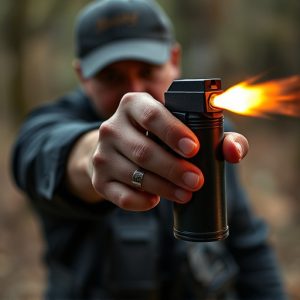Maximizing Pepper Spray Lifespan: Techniques & Best Practices for Control
Pepper spray, a non-lethal riot control agent, has evolved since its introduction in the late 20th c…….
Pepper spray, a non-lethal riot control agent, has evolved since its introduction in the late 20th century, with capsaicin as its key active ingredient from chili peppers. Modern formulations enhance range, effectiveness, and crucially extend shelf life for reliable access in emergency situations by law enforcement. Effective storage conditions, including cool, dry places away from light, are vital to maintain pepper spray potency. Best practices include proper handling, secure storage, regular inspection, testing, and adherence to manufacturer guidelines for optimal shelf life extension.
“Uncovering the Power and Perils: An In-Depth Look at Inflammatory Sprays in Riot Control
Inflammatory sprays, particularly pepper spray, have become a defining tool in law enforcement and riot control. This article delves into the multifaceted world of these chemical agents, exploring their composition, historical use, and impact on public safety. We dissect critical factors influencing pepper spray shelf life, offering valuable techniques for extension. Additionally, essential safety measures and best practices are highlighted to ensure responsible handling and storage.”
- Understanding Pepper Spray: Its Composition and Functionality
- The Role of Inflammatory Sprays in Riot Control: A Historical Perspective
- Factors Affecting Pepper Spray Shelf Life
- Techniques to Extend the Lifespan of Pepper Spray
- Safety Measures and Best Practices for Handling and Storing Pepper Spray
Understanding Pepper Spray: Its Composition and Functionality
Pepper spray, a common tool in riot control and self-defense, is a powerful chemical agent designed to incapacitate individuals temporarily. Its primary active ingredient is capsaicin, derived from chili peppers, which stimulates sensory neurons, causing a burning sensation and temporary blindness. The spray’s functionality lies in its ability to disrupt an individual’s balance and vision, providing users with a crucial window of opportunity for escape or de-escalation.
The composition of pepper spray includes not just capsaicin but also various other chemicals like lachrymatory agents, which enhance its irritant properties. Modern formulations focus on improving the spray’s range, effectiveness, and shelf life extension. Pepper spray’s longevity is a critical factor in law enforcement and security operations, as it ensures preparedness and ready access to this vital tool when needed.
The Role of Inflammatory Sprays in Riot Control: A Historical Perspective
The use of inflammatory sprays, commonly known as pepper spray, in riot control has a rich historical background that dates back to the late 20th century. Initially designed for law enforcement self-defense, its application in crowd control and riot scenarios quickly became evident. Over time, pepper spray has evolved from a basic irritant to a sophisticated tool, with various formulations tailored for different tactical needs. Its non-lethal nature makes it a preferred choice for law enforcement agencies worldwide, allowing them to effectively manage civil unrest while minimizing the risk of fatal injuries.
Historically, the development of pepper spray was driven by the need for a less lethal alternative to firearms. As protests and civil disturbances became more frequent, especially during the 1960s and 1970s, law enforcement sought safer methods to control crowds. The discovery and refinement of capsaicin, the active ingredient in chili peppers, led to the creation of pepper spray. Since then, advancements in formulation and delivery systems have significantly improved its effectiveness and shelf life extension, making it a staple in riot control equipment worldwide.
Factors Affecting Pepper Spray Shelf Life
Several factors influence pepper spray’s shelf life, impacting its effectiveness and potency over time. One key aspect is storage conditions. Extreme temperatures, both hot and cold, can degrade the spray’s active ingredients, reducing its impact. Optimal storage is at cool, dry, and dark places, mimicking the environment inside a first aid kit. Humidity levels also play a role; high humidity can accelerate spoilage, making proper packaging and airtight seals crucial.
Another significant factor is exposure to light. Direct sunlight or artificial lighting can break down pepper spray’s chemical structure, causing it to lose potency. This is why many manufacturers recommend storing the cans in opaque containers or locations shielded from light. Additionally, age itself is a determining factor; as pepper spray ages, its active components may degrade, leading to reduced performance when deployed during riot control situations. Regularly checking expiration dates and replacing old stock is essential for maintaining optimal effectiveness.
Techniques to Extend the Lifespan of Pepper Spray
Extending the lifespan of pepper spray is crucial for effective riot control and optimal resource management. One key technique involves proper storage, including keeping it in a cool, dry place away from direct sunlight or extreme temperatures. This environment prevents chemical degradation that can significantly shorten its shelf life. Additionally, maintaining the spray in its original packaging ensures protection against moisture and other environmental factors.
Another strategy is to invest in high-quality pepper spray with robust formulations designed for longevity. Some manufacturers incorporate ingredients that inhibit oxidation, a major cause of spoilage. Regular inspection and checking for signs of damage or leakage can also help prolong its useful life. Using it promptly after opening, along with storing unused portions securely, ensures the spray remains potent when needed most during riot control scenarios.
Safety Measures and Best Practices for Handling and Storing Pepper Spray
Handling and storing pepper spray safely is paramount to ensure its effectiveness and prolong its shelf life. First and foremost, always wear protective gear, including gloves and safety glasses, when handling the spray to avoid direct contact with skin or eyes. Store pepper spray in a cool, dry place away from direct sunlight and heat sources, as extreme temperatures can degrade its potency. Keep it tightly sealed and out of reach of children and pets. Regularly inspect the spray for any signs of damage or leakage, and dispose of it promptly if expired or compromised. Many manufacturers provide specific guidelines for pepper spray shelf life extension, so consult the product labeling for recommended disposal instructions.
Best practices also involve securing the storage area with a lockable container or cabinet to prevent unauthorized access. Periodically test the spray’s functionality by releasing the trigger and ensuring it dispenses evenly. Avoid shaking the canister unnecessarily, as it can create pressure buildup that could potentially lead to accidental discharge. Remember, proper handling and storage are key to maximizing the effectiveness of pepper spray and extending its useful life.
Pepper spray, a potent riot control tool, has evolved significantly over history. Understanding its composition, effectiveness, and proper handling is crucial for maximizing its lifespan and ensuring safe deployment. By considering factors like storage conditions and adopting techniques to extend the pepper spray shelf life, law enforcement agencies can maintain a reliable resource during chaotic situations. Adhering to best practices guarantees the spray remains effective when needed most, making it an indispensable asset in riot control strategies.


